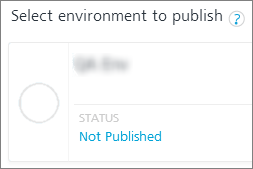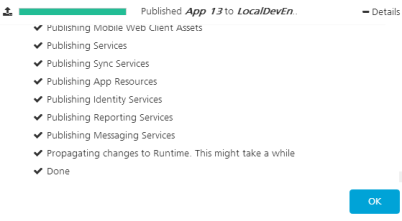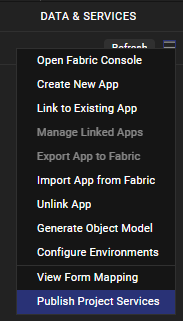Publish a Quantum Fabric App
Until an app is published, all its services and features are limited to just the Quantum Visualizer development environment. To connect the app to live services, you have to publish the application to Quantum Fabric. After you have signed in to Quantum Fabric, you can select and publish your app to any of your cloud accounts. You can publish your app from the Quantum Fabric Console by using the Publish tab.
Prerequisites
Before you can publish an app to Quantum Fabric, you must meet the following prerequisites:
- Have a Quantum Fabric account.
- Configure Quantum Fabric in Quantum Visualizer.
- Create a Quantum Fabric app corresponding to the Quantum Visualizer app that you are publishing.
For more information, refer Connecting to Services and Getting Started with Quantum Fabric.
IMPORTANT: If your app contains deprecated widgets, it is possible that their skins may refer to the Helvetica font. If you are not explicitly using Helvetica in your app, you must verify your app's configuration and manually remove references to Helvetica before submitting it to the store.
This topic contains the following sections:
Directly Publish an App to Quantum Fabric
From Quantum Visualizer V8 SP4 FP 35 onwards, an option to directly publish your app to Quantum Fabric has been provided.
To directly publish an app to Quantum Fabric, follow these steps:
- In Quantum Visualizer, sign in to your Quantum Cloud account. To do so, from the upper-right corner of the Quantum Visualizer window, click Login. The Quantum Account sign-in window opens. Type your Quantum Cloud email and password credentials, and then click Sign in. Quantum Visualizer uses the configured Quantum Fabric URL to sign in to Quantum Fabric.
NOTE: You can configure the Quantum Fabric URL by going to: Edit > Preferences > Quantum Fabric.
IMPORTANT: If you are not able to get beyond the login page for the Quantum Fabric Console, it could be because you set up Quantum Fabricby using a self-signed certificate. The self-signed certificate allows you to install Quantum Fabric, however, which Windows and Google Chrome do not trust the allow you to sign in. To resolve this issue, locate the certificate (you may need to contact your system administrator to do so), and then import it to the Trusted Root Certification Authorities folder of the Windows Certificate Store. For more information on how to import a certificate into the Windows Store, refer Import or export certificates and private keys on the Microsoft web site.
- Select a default environment for Quantum Fabric. To do so, on the Project Explorer, click Project Settings.
- Click Quantum Fabric.
At the top of this tab, under Quantum Fabric Environment, select an environment from the drop-down list. Click Done. If you do not see any environments listed, you need to create one. For more information, refer Environments in the Quantum Fabric Console User Guide.
NOTE: If an environment contains an alias hostname, the alias is used in the generated App Service Document. The alias is used to make service calls from the client app.
- To publish to Quantum Fabric, your Quantum Visualizer client app must be associated with a Quantum Fabric app, which means that you need to either create a new Quantum Fabric app or use an existing one. To do so, at the upper-right corner of the Data & Services panel, click the hamburger menu icon hamburger menu icon
 , and then click either Create New App or Link to Existing App. From the Quantum Fabric Application dialog box, select the app to which you want to associate your Quantum Visualizer app. For more information about how to create a new Quantum Fabric app, refer How to Add Applications in the Quantum Fabric Console User Guide.
, and then click either Create New App or Link to Existing App. From the Quantum Fabric Application dialog box, select the app to which you want to associate your Quantum Visualizer app. For more information about how to create a new Quantum Fabric app, refer How to Add Applications in the Quantum Fabric Console User Guide.
Once you link your Quantum Visualizer client app with a Quantum Fabric app, the name of the linked Quantum Fabric app is displayed beside Fabric Backend on the Data & Services panel. Here, App 1 is the associated Quantum Fabric app.
- Right-click Quantum Fabric for the linked app, and then click Publish Project Services. The app is successfully published to Quantum Fabric.
NOTE: If you have not done so earlier, a dialog box appears asking you to select a valid Quantum Fabric environment.
Publish the App from Quantum Fabric
After you have published your app to Quantum Fabric from Quantum Visualizer, you can publish the app from Quantum Fabric. This feature is applicable only in Kony Visualizer Classic.
To publish your app from Quantum Fabric, follow these steps:
- Once you have selected a Quantum Fabric app to which you want to bind your Quantum Visualizer app, the Quantum Fabric Console opens. On the Quantum Fabric console, click the Publish tab.
- If the Quantum Fabric app to which you have bound the client app has not yet been published, select the app for publish.
- Click Next. The Environments page appears.
- The Configure page displays options to change the configuration of your Services. To make any changes, click + Service Configuration., and then click any of the blue-text fields.
- If available, you can reconfigure the application-level settings and service configuration settings from this page .
- Click Save and Publish. The app and any associated services are published to the selected environment.
- To close the Quantum Fabric Console and return to Quantum Visualizer, from the Quick Launch Bar along the upper left edge of Quantum Visualizer, click the Visualizer icon
 . Since you are still logged in to your Quantum account, Quantum Visualizer continues to have access to your Quantum Fabric apps and services.
. Since you are still logged in to your Quantum account, Quantum Visualizer continues to have access to your Quantum Fabric apps and services. - Launch the app. To do so, on the Product menu, navigate to Run As, and then select an emulator to run the app on.

The status of the environment to which you want to publish the client app indicates whether the Quantum Fabric app has been published.
| Status when Not Published | Status when Published |

|

|


NOTE: If your app is an upload of web app (such as Desktop Web/ Responsive Web, or Progressive Web App) binary , the Configure page displays a drop-down list of options specific to the web client environment.
NOTE: If you are building a Quantum Visualizer web app (such as Desktop Web/ Responsive Web, or Progressive Web App), you must first define and publish any required Quantum Fabric services. After you build any web application and upload its binaries to Quantum Fabric, you cannot publish a service to it.
If you encounter an error while publishing the Quantum Fabric, try publishing again.

Environment List in Visualizer
Prior to Visualizer V9 release, it lists only the environments to which you have full access. From Visualizer V9 onwards, you can view the list of all environments associated with your Fabric account. This list includes the environment with both full and read-only access.
The different types of access that a cloud account admin can provide, are:
- Full Access: When your cloud account has Full Access, you can build your application and publish your services to Quantum Fabric. The environment with full access is listed in Visualizer.
- No Access: When your cloud account has No Access, you cannot build and publish your application to Quantum Fabric. The environment with no access is not listed in Visualizer.
- Custom: When your cloud account has Custom access, your cloud account is provided with permissions depending on the features/components. These features/components include Server, Engagement, etc.
You must have one of the following feature level permissions to build your application and see these environments listed in Visualizer:
- Build Client App
- Server
The following table shows the actions you can perform for each access.
| User Access Type | Environment Access Type | View Environments in Visualizer | Build native Application | Build Web Application | Publish the Services |
|---|---|---|---|---|---|
| Full Access | Full Access | Yes | Yes | Yes | Yes |
| No Access | No Access | No | No | No | No |
| Custom | Build Client App | Yes | Yes | No | No |
| Custom | Server | Yes | Yes | Yes | Yes |
For more information about the different environment permissions of your cloud account, click here.

